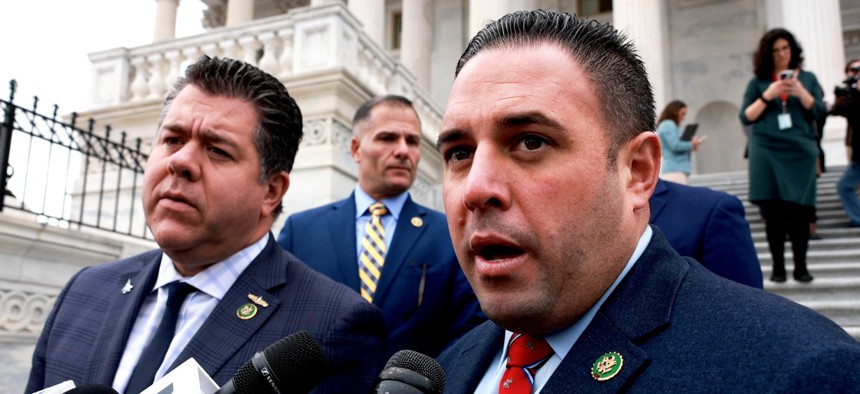Albany Agenda
Joint fundraising committees are funneling huge amounts of money into NY House races
The unique structure of the committees allows them to fundraise for multiple candidates – from big donors.

From left, Republican Reps. Nick LaLota, Marc Molinaro (background) and Anthony D’Esposito Photo by Alejandra Villa Loarca/Newsday RM via Getty Images
In the money game for Congress, many candidates in highly contested races in New York are getting significant boosts from major fundraisers like House Speaker Mike Johnson and former House Speaker Kevin McCarthy. Republicans in particular are making use of joint fundraising committees to transfer large sums of cash from wealthy donors to swing districts around the state.
Although they are not new, joint fundraising committees are hot this cycle as some candidates for president make use of them and big fundraisers hope they will help swing control of the House. Unlike candidate committees or traditional political action committees, a joint fundraising committee can fundraise for multiple candidates and/or PACs, and disperse the money accordingly. As NBC reported, they rose in popularity after a 2014 Supreme Court decision struck down aggregate candidate donations limits, allowing wealthy donors to max out their contributions to as many candidates they want. Previously, an individual could not give more than roughly $50,000 per election cycle total among all candidates they donated to.
Individual contribution limits still apply, but joint fundraising committees permit wealthy donors to write a single large check to one committee which is then responsible for allocating those funds to other candidates and other committees within the legal limit. For example, if a joint fundraising committee is soliciting cash for two candidates, they can accept up to $13,200 from a single donor, but only $6,600 (the cycle limit for an individual) can go to each candidate.
On the Republican side, both Johnson and McCarthy set up such committees that are capable of accepting six-figure donations due to how many candidates they are authorized to fundraise for. Protect the House 2024, McCarthy’s committee, is associated with over two dozen candidates around the country, including Reps. Mike Lawler, Anthony D’Esposito, Brandon Williams and Marc Molinaro. The associated Protect the House New York also includes Reps. Nick LaLota, Andrew Garbarino and Nicole Malliotakis. Johnson’s Grow the Majority and the associated Grow the Majority NY is fundraising for over three dozen candidates, including all the same New Yorkers and Reps. Elise Stefanik and Claudia Tenney. It’s also fundraising for a different joint fundraising committee for whoever emerges as the Republican candidate in the 18th Congressional District, currently held by Democratic Rep. Pat Ryan.
Lawler has received nearly $400,000 in transfers from McCarthy’s committees since the start of the election cycle, and about $22,000 from Johnson’s committee. That’s out of roughly $3.3 million he has raised so far for his reelection. Molinaro has gotten about $400,000 in transfers from McCarthy’s committees and over $34,000 from Jonhson’s committee. Molinaro has brought in a total of $2.2 million since the start of the cycle. LaLota has received over $100,000 in transfers from McCarthy’s Protect the House New York, and a little under $41,000 from Johnson’s Grow the Majority and Grow the Majority NY. That’s out of $1.6 million total that LaLota has raised since the start of last year. D’Esposito has gotten over $400,000 in transfers from McCarthy’s committees and over $33,000 from Johnson's committees. D’Esposito has brought in a total of $2 million. Williams also got about $400,000 in transfers from McCarthy’s committees, as well as about $35,000 from Johnson’s fundraising efforts. He has raised a total of $1.7 million this cycle.
Rep. Pat Ryan, the main Democratic incumbent this year that the party is trying to protect, has received over $41,000 from the Democratic Future Leadership Fund, which raises money for about a dozen Democrats across the country. Ryan is the only New Yorker on that list and has raised a total of about $3.1 million since the start of last year.
Many of these candidates have also raised money in their own joint fundraising committees and have transferred large sums over to their main campaign accounts. Democrats have done this as well, but Republicans have made use of the practice much more this cycle. Incumbents – or in the case of Democrat Mondaire Jones, former members who are seeking a seat – often have joint fundraising committees that raise money for their main campaign committee as well as their leadership PAC and federal or local party committees. Unlike the national fundraising efforts of Protect the House or Grow the Majority, the individual candidate’s team is usually running their joint fundraising committee to allow potential donors to write one check for multiple committees associated with the candidate, rather than several individual checks.
Correction: Transfer totals were adjusted slightly after publication for accuracy.
NEXT STORY: U.S. Attorney Damian Williams’ most significant cases

